ISKME's Use Case Design Lab, Hewlett OER Grantees Meeting 2014
Goals
- Experience
ISKME’s process of using design thinking to showcase use cases and articulate
value
propositions
- Work together through a real example that is ripe for creating a use case and ready for analysis and feedback
- Discover new insights into current projects and present use case success scenarios and unique value propositions
Design Lab Overview

Standout Storytelling
Goal: Celebrate the various ways grantees have been successful in the OER space during the past year.
Materials: 150 Gold Star Templates, 150
black sharpies, 6 six foot rectangle tables labeled: tools, skills, practice,
policy, research, wild card
Activity:
Intro (10 mins): Welcome! There are many ways that this community has stood out in the OER space over the past year. During this activity we are going to reflect, learn, and celebrate the ways we have each stood out in the OER space. In triads, participants share one example of how they have “stood out” in the past year. The example you share should be something new, exciting, and innovative that you have contributed to the OER space. Pick an example that they are most excited about.
Share some examples:
- ISKME – Kate Katz: online authoring and remixing toolkit to create primary source OER (tool)
- Mountain Heights Academy – DeLaina Tonks: Next Gen OER - student created OER (practice)
- Siyavula – Mark Horner: signed a memorandum with South Africa Ministry of Education (policy)
Share in triads (10 mins): Triads have 10 minutes to share their examples.
Fill out Gold Star (10 mins): Then participants are given the Standout Gold Star template to fill in their name, their organization or institution’s name, and a description of their example in ten words or less. See example below.
Share out (5 mins): After participants fill in their Standout Gold Star templates, the facilitator calls on a few to share out their examples with the large group, and discuss the themes that emerge (types of stand outs include: tools, skills, practice, policy, research, wild card).
Table themes (10 mins): The participants then take their Standout Gold Stars to tables with the types of stand outs labeled. At their tables, participants share their examples. Facilitator congratulates the participants and celebrates them for the many ways they have all stood out this past year.
Awards (5 mins): Each table will come up with an award for their group to celebrate the fantastic work they all did this past year. Some award titles could be: Most Improved, Best OER Support, Most Likely to Succeed, Best Team Player, Rookie of the Year, Rising Star, Most Valuable Player, Most Memorable, Most Distinguished, International OER Hero, Medal of Honor
Closing (5 mins): Over the next two days, they will build on these examples to identify evidence, use cases, and value propositions. Groups will be created based on stand out types. Standout Gold Stars will be put on display in the foyer.
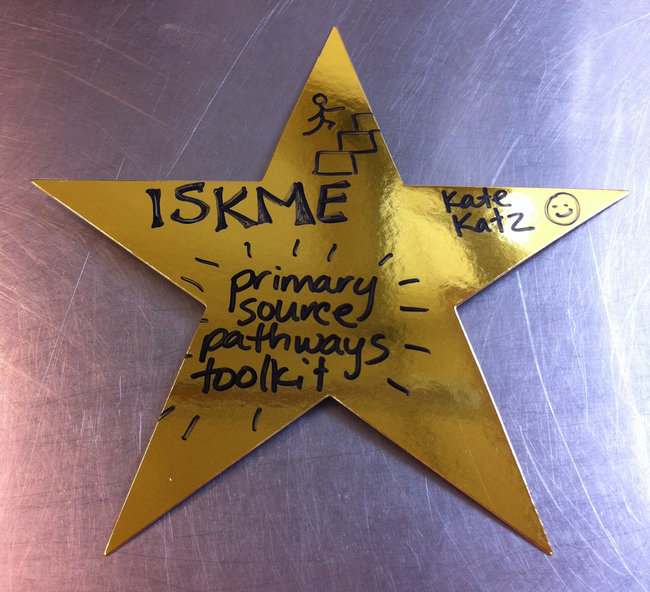
Identify Evidence Indicators
Introduce the evidence indicators worksheet and identify and add evidence indicators for each participant's Standout Example. They will refer to these indicators throughout the Design Lab.
Prototype Use Case
Goals: Learn a process using design thinking to develop use case scenarios and work through a real example that is ripe for creating a use case and ready for analysis and feedback.
Materials per room: 6 easel pad templates with goal/user/stakeholder, prototyping materials, 6 storyboard templates, 5 rolls of tape, 5 scissors, 5 stacks of small stickies, 5 stacks of large stickies, 30 sharpies, 1 easel pad
Activity:
Evidence indicators share in large group (5 mins): Discuss the evidence indicators related to their stand out examples, share any additions they have. Facilitators create small groups of five participants.
Discussion and goal articulation in small groups (15 mins): Small groups share their examples and select one Standout Example and associated evidence to work through using the easel pad template below. Suggested criteria for the small groups to use to select the stand out example include, the evidence indicators, and newest, most exciting, and innovative example that is ripe for creating a use case and ready for analysis and feedback.
- Title: "existing goal the use case is trying to satisfy”
- Primary user
- Stakeholders and Interests
Introduce Prototyping in large group (5 mins): Why we prototype – build to think, collaboratively work together to create a working 3-D model of the use case success scenario, discuss what works and what doesn’t, what should be moved/added/removed/etc. Prototyping is a tool for groups to get ideas out of their heads and into a working models that can be modified and build upon collaboratively. New insights into the use case will emerge during the collaborative prototyping.
Prototype in small groups (20 mins): The selected stand out example representative will quickly list the five steps the user takes to complete the goal on an easel pad. Each group member will be assigned one of the five steps and silently build a 3-D model of what the user is doing during that step. Then each group member will share their prototype and see how they fit together to represent the use case success scenarios. They will have 15 mins to continue to build a prototype that shows the main success scenario: the steps the user takes to accomplish the goal and the outcome(s). New insights should emerge into the use case through collaboratively prototyping, and should be included in the prototype.
Present prototypes to the group next to them, share insights, and get feedback in small groups (10 mins).
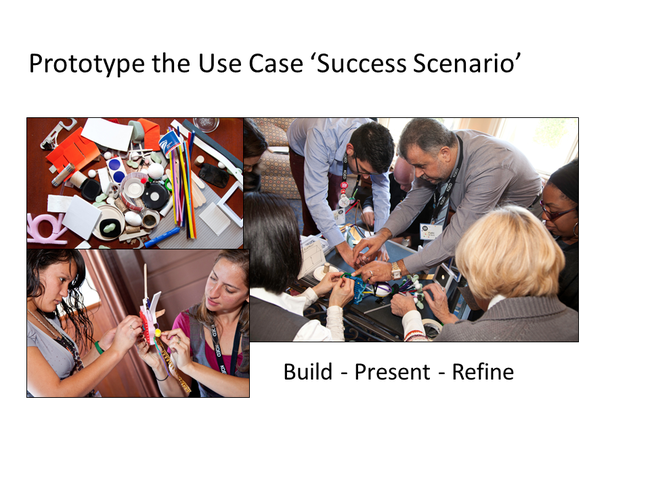
Storyboard the Moments that Matter
Refine prototype, identify the steps that matter most, and create storyboard using the storyboard template in small groups (20 mins): Articulate what user is doing in each of the nine steps and why it matters through sketches, thought bubbles, conversation bubbles, and short descriptions.
Storyboard & Prototype Gallery Walk in large group (15 mins): Present storyboards and reference prototypes to the entire group via gallery walk (2 mins per presentation).
Closing in large group (5 mins): Congratulate the groups for the great work they did. In the next session they will build on the use case prototypes and storyboards to brainstorm and present unique value statements.
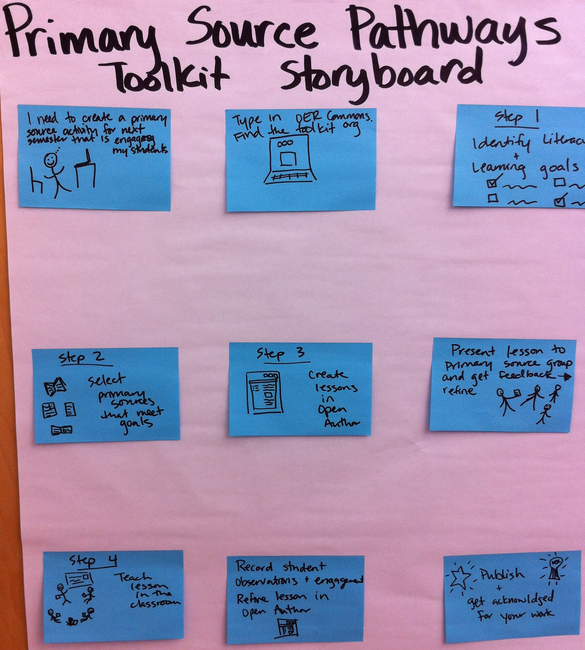
Determine Value Proposition
Goal: Build on use case prototypes and storyboards to brainstorm and present unique value propositions.
Materials per room: 6 easel pad value proposition templates, 5 stacks of small stickies, 30 sharpies, 1 easel pad
Activity:
Facilitator introduces the unique value proposition template and discusses guidelines for creation in large group (5 mins): Statements should be clear, specific, succinct, memorable, easy to understand, engaging, compelling, provocative, articulate the unique value and what is highly desirable to the user.
Value Proposition Brainstorm in small groups (15 mins): Revisit storyboard and select the moments that matter most (three or four). Small groups brainstorm unique value proposition components using the easel pad template and stickies.
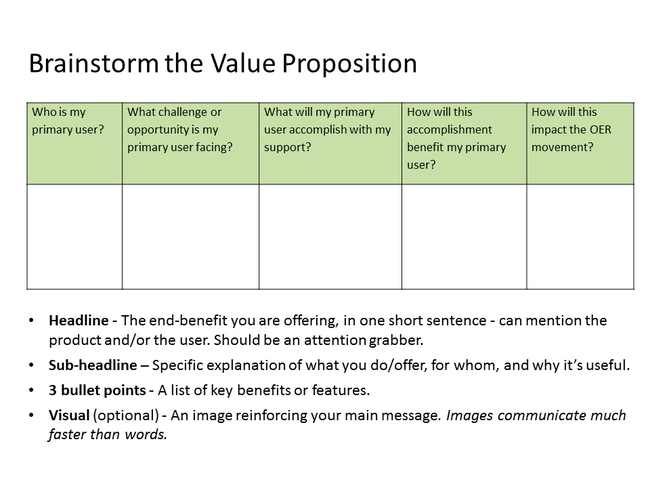
Value Proposition Articulation in small groups (15 mins). Write the value proposition and sketch an image on easel pads. Each value proposition should have the following components.
- Headline. The end-benefit you are offering, in one short sentence - can mention the product and/or the user. Should be an attention grabber.
- Sub-headline or a 2-3 sentence paragraph. Specific explanation of what you do/offer, for whom, and why it's useful.
- 3 bullet points. A list of key benefits or features.
- Visual. An image reinforcing your main message. Images communicate much faster than words.
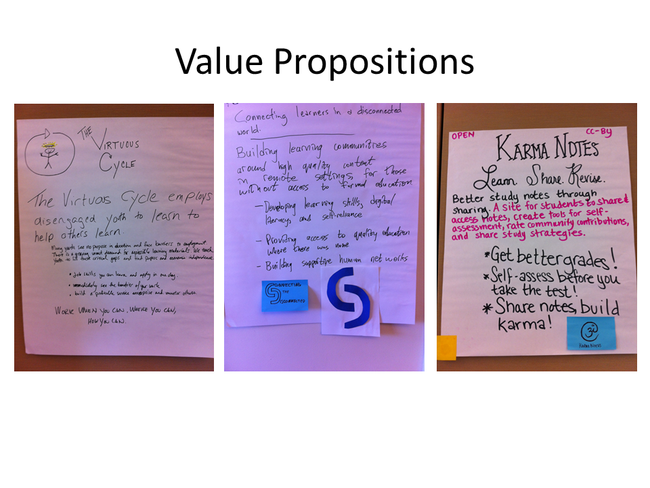
Present and Feedback in large group (30 mins): Once completed, they present the value statements to the group and get feedback (5 mins per group).
Refine value propositions in small groups (15 mins).
Final presentations in large group (15 mins): Facilitators capture video of presentations on flipcams (2 mins per group).
Closing (10 mins): Reflect on the activities of the day and share highlights and takeaways. How will they use what they experienced and learned in their work? What will they do next?
Tweet #OERvalue Propostion
Goal: Individual articulation of value propositions, sharing, and feedback using twitter.
Materials: 150 #OERvalue proposition handouts, pens, value proposition videos
Activity:
Introduction (10 mins): Recap yesterday – evidence indicators of success, use case success scenario prototypes and storyboards, and value propositions.
Value Proposition Video Showcase (10 mins): Play four videos of unique value propositions created yesterday.
Individual Value Proposition Creation (10 mins): Participants fill out the value proposition handouts, with the guidelines in mind. Share and refine with a partner. Show value proposition components (headline, sub-headline, benefit bullet points, and image) and examples from yesterday on screen.
Tweet (10 mins): In 131 characters or less, participants tweet the final version of their value proposition with the hashtag #OERvalue. Share some examples from yesterday in 131 characters or less. Show live twitter feed of #OERvalue on the screen.
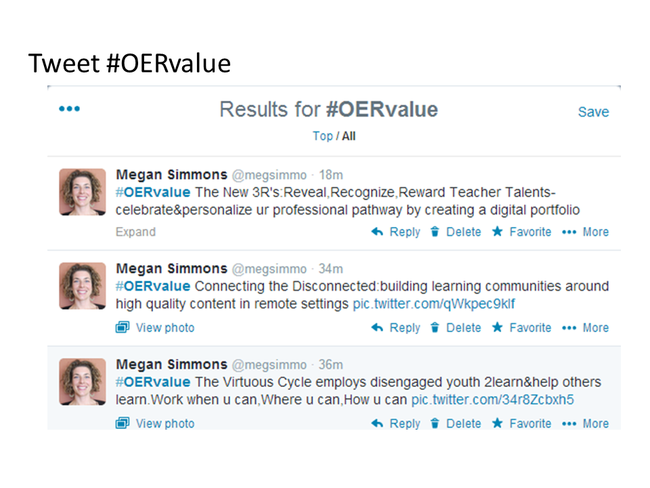
Closing
(5 mins): Celebrate the dynamic OER community and the value we each bring to
the OER movement. Invite participants to continue to share and refine their
value propositions and connect with those that stood out to them.